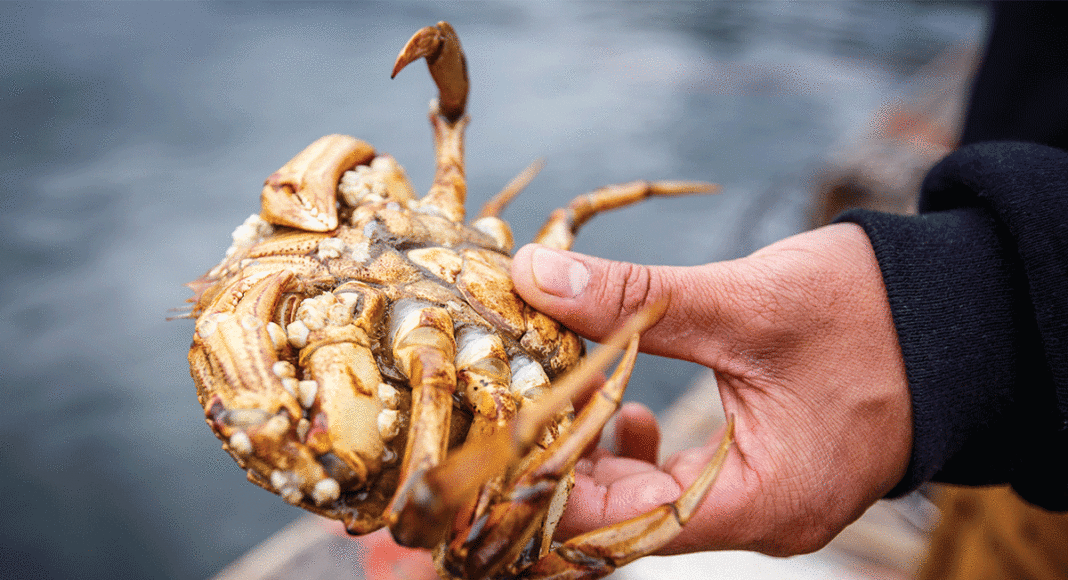Fishermen loaded up their vessels with crab pots at the Santa Cruz harbor last weekend to brave the swells for the recreational crab season, which kicked off Saturday, Nov. 5.
While the hobbyists got a head start, the commercial fishermen aren’t far behind, as the commercial crab season is set to open on Tuesday, Nov. 15—with no sign of delays in sight.
Crabs for Thanksgiving and Christmas are a tradition in Northern California. But last year, that tradition came to a halt in Santa Cruz and elsewhere because of dangerously high levels of domoic acid, a neurotoxin and natural byproduct of algae blooms. The larger 2015 bloom began because warmer ocean temperatures had created the perfect conditions for the algae to thrive.
“We describe it as essentially the toxin saturating the environment,” says Raphe Kudela, an ocean sciences professor at UCSC who monitors domoic acid levels locally. “It ended up showing up in anchovies, crabs and sediment. Pretty much all the different organisms.”
As this year’s season gets underway, UCSC scientists and other experts are still trying to make sense of what happened last year.
Domoic acid levels typically spike around April and taper off within a couple of months, but the 2015 bloom held through November, leaving high levels of the neurotoxin long after the bloom had finished. In response, state officials delayed last year’s opening date several times, pushing it from November to March, due to high domoic acid levels. While that delay spread up the Pacific, reaching parts of Canada and Alaska, it hurt California crabbers the most.
Washington and Alaska saw catch decreases of roughly 22 percent and 33 percent, respectively, according to a joint report by the U.S. Department of Commerce, the National Oceanic and Atmospheric Administration, and the National Fisheries Service. But in California, fishermen pulled in only 3.1 million pounds of Dungeness crab, a decrease of 83 percent from the 18.4 million pounds they hauled in during the 2014 season.
The domoic acid levels also led to a surge in the number of marine mammal strandings. The Marine Mammal Center in Sausalito saw 235 California sea lions and Guadalupe fur seals come in with signs of domoic acid poisoning in 2015, compared to around 70 in typical year. Other animal rescue organizations reported similar spikes, according to Giancarlo Rulli, a spokesperson with the center.
“As an apex predator in the ocean, they offer us a glimpse into the overall health of what’s going on out there,” he says, because the mammals sit at the top of the food chain. “If they’re coming in sick, it’s a reflection that the ocean itself is sick.”
Environmentally, it took a perfect storm of odd weather conditions to create the warm ocean temperatures and large poisonous bloom.
Last year, El Niño, which typically means warmer waters near the equator and more rain in California, was accentuated by the so-called “blob,” a warm body of water in the Pacific Northwest. That blob developed because high-pressure weather systems deflected storms that typically churn the ocean waters and cool the temperatures, explains Michael Jacox, a research scientist with UCSC and NOAA Southwest Fisheries Science Center.
“For a couple winters in a row, we didn’t get that mix in. So that typical wintertime cooling didn’t happen and there was this buildup of heat,” he says.
Jacox says the phenomenon is an anomaly, and not a new norm for ocean temperatures, although he adds, “The question then is whether these kind of extremes happen more often as the climate changes. There’s some research that suggests this kind of thing will happen more often. Or the alternative piece is [that] even as things warm, that variability is on the warmer base line.”
While the 2016 season did not repeat the 2015 season domoic acid crisis, it offered its own puzzling conditions—for instance, why did the toxic bloom start in June instead of April?
“That was also worrying because, if we shifted everything, then you might actually impact the opening of the crab season again,” Jacox says. Fortunately for crabbers, the toxicity peaked in late September, and levels have been trending down since.
The state did issue an advisory for crabs caught north of Point Reyes because of sporadic detections of high neurotoxin levels, but domoic acid levels up and down the California coast are mostly in check. Kudela says the upcoming crabbing season is in good shape, so he and state officials aren’t expecting anything similar to last year. But he warns that the recent disruptions could be a sign of future shifts in the world’s climate—especially after 2015 went down as the hottest year on record.
“I think it’s a pretty clear sign,” Kudela says. “We’ve never seen a warm blob like that before, and it’s restructuring the atmosphere and ocean. It’s not a natural phenomenon or else we would’ve seen something like that before.”













